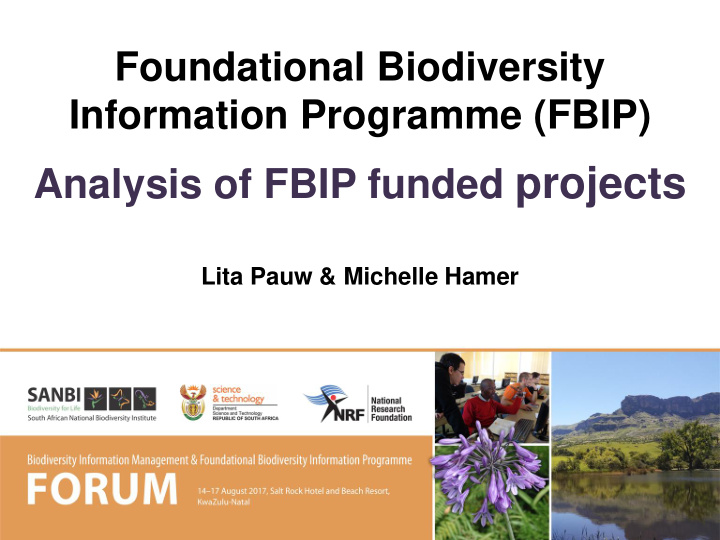



Foundational Biodiversity Information Programme (FBIP) Analysis of FBIP funded projects Lita Pauw & Michelle Hamer
Outline • Grants awarded: 2013-2017 • FBIP bursaries awarded to students & other support • Types of projects & data outputs • Some qualitative examples of outcomes
Small Grants & Surveys: 2013-2017 Proposals received: 292 Successful: 94 Unsuccessful Awarded 80 70 60 50 40 30 20 10 0 2013 2014 2015 2016 2017*
Large Grants: 2013-2017 Unsuccessful Awarded 20 18 16 14 12 10 8 6 4 2 0 2013 2014 2015 2016 2017*
10 15 20 25 30 35 40 45 50 0 5 SU Grants awarded per Institution ARC UP Museums RU UCT UFS SAEON SANBI WITS SAIAB Unsuccessful UJ UKZN NGOs NMMU UM UWC CPUT EKZNW Awarded NWU UNIVEN CSIR DUT MRC NZG SMU TUT UNISA UFH UL
Age at which grantholders received award (all years combined) 45 40 35 30 Number 25 20 15 10 5 0 <30 30-40 41-50 51-60 61+ Age
FBIP bursaries awarded to students (2014-2017)
Other support Postgraduate Students • FBIP grants supported 41 postgraduate student projects • Travel support for students to attend the annual BIMF-FBIP Forum and Postgraduate Forum (20/year) • Travel support for 13 students to attend the iBOL conference in 2017 Technical assistants • 19 student assistants contracted and trained through funded projects Young researchers • Opportunity for 14 young researchers to resubmit a revised proposal Training workshops • Several training workshops presented annually during the BIMF-FBIP Forum • SPECIFY training in October 2016
Types of projects funded relative to the global diversity of the group % of global species % of projects funded 80 70 60 % of Total 50 40 30 20 10 0 Viruses & Fungi Invertebrates Vertebrates Plants Bacteria
10 15 20 25 30 35 40 0 5 Surveys - 1 group Type of data outputs DNA Barcoding Phylogeny / taxonomy Data mobilization Surveys - multitaxa Population genetics Citizen science & community involvement
Summary of expected outputs Total expenditure: R35 million • Specimen / occurrence records : 520 000 covering 9 000 localities and 22 000 species (20% of SA’s species) • DNA barcoded : 3 700 species and 8 000 specimens • Descriptions of 20 + microbe communities from soil, roots • Species pages : 2 400 species pages • Species discovered : 600 species revised, >20 new • Postgraduate students bursaries : 59 • Papers published : estimated 170 (71 published to date)
Some qualitative examples of outcomes • Seakeys project held a workshop which brought researchers and bioprospecting investigators together. Highlighted that an endemic seaslug has led to the discovery of a compound with promising results against oesophagal cancer. • Providing new material for ongoing research on an endemic medicinal hemichordate “worm” which has the most powerful compound ever tested against cancer in the US. This “worm” species, which was previously considered scarce, is caught as bycatch in the demersal research trawls on which the team has been supporting monitoring work.
Some qualitative examples of outcomes • Discovery of new species: BioGaps project – large number of new species (eg. 15 grasshoppers, several plants) in Karoo which is under mining threats. • Training of tour guides from Ndumo Game Reserve to find and identify frogs.
Thank you
Recommend
More recommend